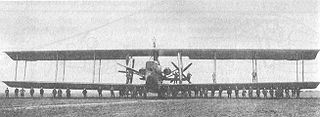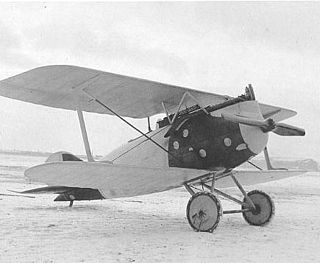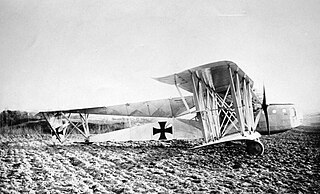Related Research Articles

The Zeppelin-Staaken R.VI was a four-engined German biplane strategic bomber of World War I, and the only Riesenflugzeug design built in any quantity.

A Riesenflugzeug, sometimes colloquially referred to in English as an R-plane, was any member of a class of large World War I German bombers, possessing at least three aircraft engines, although usually four or more engines. These large multi-engine aircraft could fly several hours with larger bomb loads than the smaller Grossflugzeug bombers such as the Gotha G.V.

The Roland D.VI was a German fighter aircraft built at the end of World War I. It lost a fly-off to the Fokker D.VII, but production went ahead anyway as insurance against problems with the Fokker.
Numbers 467 to 470 were four examples of a unique seaplane design produced for the flying service of the Imperial German Navy during the First World War. These four aircraft were the subject of an order by the Navy for trainer seaplanes for the base at Putzig, at a time when most trainers were merely obsolete front-line types.

Imperial German Navy seaplanes 461 and 462 were the only two examples of a seaplane design produced for the Navy's flying service during the First World War. Number 461 was built in October 1916 and Number 462 in September 1917 as the German seaplane bases searched for purpose-built training aircraft to supplement their collection of retired combat types.

The Rumpler B.I was a military reconnaissance aircraft produced in Germany during World War I.

The Rumpler C.III was a biplane military reconnaissance aircraft built in Germany during World War I.

The Rumpler D.I was a fighter-reconnaissance aircraft produced in Germany at the end of World War I. It was a conventional single-bay biplane with wings of unequal span braced by I-struts. It featured an open cockpit and a fixed, tailskid undercarriage. The upper wing was fitted with aerodynamically balanced ailerons and fuselage had an oval cross-section.

The Rumpler G.I was a bomber aircraft produced in Germany during World War I, together with refined versions known as the G.II and G.III.
The Sablatnig SF-5 was a reconnaissance seaplane produced in Germany during the First World War.
The Siemens-Schuckert R.I was a bomber aircraft built in Germany during World War I. It was originally ordered as the Siemens-Schuckert G.I prior to the German Inspectorate of Flying Troops adopting the "R" classification for multi-engine aircraft in late 1915. Some sources refer to the aircraft as the Siemens-Schuckert Steffen R.I, including the name of the brothers that designed it.

The Siemens-Schuckert Forssman was a prototype bomber aircraft designed and built in Germany in 1914 and 1915. When its performance proved inadequate for its intended role, even after numerous modifications, the German Inspectorate of Flying Troops eventually accepted it into service as a trainer. Shortly after its acceptance into military service, the aircraft's fuselage fractured while on the ground, ending its career.

The Siemens-Schuckert R.VIII was a bomber aircraft designed and built in Germany from 1916.

The Siemens-Schuckert R.II was a prototype bomber aircraft built in Germany during World War I. It was one of six aircraft based on the Siemens-Schuckert R.I that were originally intended to be identical, but which each developed in a different direction and were designated as different aircraft types by the German Inspectorate of Flying Troops. Although the R.II was the first of the batch to be completed, it was the last accepted into military service, and then only as a trainer.
The Siemens-Schuckert R.IV was a bomber aircraft built in Germany during World War I. It was one of six aircraft based on the Siemens-Schuckert R.I that were originally intended to be identical, but which each developed in a different direction and were designated as different aircraft types by the German Inspectorate of Flying Troops. The Maybach HS engines specified by the Idflieg proved unreliable, but with these engines were replaced by Benz Bz.IV engines, the R.IV saw service on the Eastern Front before being relegated to training duties.
The Siemens-Schuckert R.V was a bomber aircraft built in Germany during World War I. It was one of six aircraft based on the Siemens-Schuckert R.I that were originally intended to be identical, but which each developed in a different direction and were designated as different aircraft types by the German Inspectorate of Flying Troops. Development of the R.V benefited from the experience that Siemens-Schuckert and the Idflieg had gained with the R.II, R.III, and R.IV, particularly in its choice of powerplants, where the R.V was spared from the troublesome Maybach HS engine. Between September 1916 and February 1917, the aircraft saw service on the Eastern Front before it was damaged in an accident and dismantled for spare parts.

The Siemens-Schuckert R.VI was a bomber aircraft built in Germany during World War I. It was one of six aircraft based on the Siemens-Schuckert R.I, which were originally intended to be identical. Each developed in a different direction and were designated as different aircraft types by the German Inspectorate of Flying Troops.

The Siemens-Schuckert R.VII was a bomber aircraft built in Germany during World War I. It was one of six aircraft based on the Siemens-Schuckert R.I that were originally intended to be identical, but which each developed in a different direction and were designated as different aircraft types by the German Inspectorate of Flying Troops.
The Maybach Mb.IV, originally designated Maybach HS,, was a six cylinder in-line piston engine of 250 hp (190 kW) output, originally developed for use in airships. It was also used for large aircraft such as the Zeppelin-Lindau Rs.I giant seaplane.

The Siemens-Schuckert L.I was a large, three-engined biplane bomber aircraft, built in Germany towards the end of World War I. It was a twin boom design, strongly influenced by the successful Caproni Ca.3. Three were built but not used operationally.
References
- Gray, Peter; Owen Thetford (1962). German Aircraft of the First World War. London: Putnam.
- Haddow, G.W.; Peter M. Grosz (1962). The German Giants: The Story of the R-planes 1914–1919. London: Putnam.
- The Illustrated Encyclopedia of Aircraft. London: Aerospace Publishing.
- Kroschel, Günter; Helmut Stützer (1994). Die Deutschen Militärflugzeuge 1910–1918. Herford: Mittler.
- Taylor, Michael J.H. (1989). Jane's Encyclopedia of Aviation. London: Studio Editions.